ZHCSDR1 April 2015 TPS22860
PRODUCTION DATA.
7 Specifications
7.1 Absolute Maximum Ratings
over operating free-air temperature range (unless otherwise noted) (1)| MIN | MAX | UNIT(2) | ||
|---|---|---|---|---|
| VBIAS | BIAS voltage range | –0.5 | 6.5 | V |
| VIN | Input voltage range | –0.5 | VBIAS + 0.5 | V |
| VOUT | Output voltage range | –0.5 | VBIAS + 0.5 | V |
| VON | Input voltage range | –0.5 | 6.5 | V |
| IMAX | Maximum Continuous Switch Current | 200 | mA | |
| IPLS | Maximum Pulsed Switch Current, pulse <300us, 2% duty cycle | 400 | mA | |
| TA | Operating free-air temperature range(3) | –40 | 85 | °C |
| TJ | Maximum junction temperature | 125 | °C | |
| TSTG | Storage temperature | –65 | 150 | °C |
(1) Stresses beyond those listed under Absolute Maximum Ratings may cause permanent damage to the device. These are stress ratings only, which do not imply functional operation of the device at these or any other conditions beyond those indicated under Recommended Operating Conditions. Exposure to absolute-maximum-rated conditions for extended periods may affect device reliability.
(2) All voltage values are with respect to network ground terminal.
(3) Inapplications where high power dissipation and/or poor package thermal resistance is present, the maximum ambient temperature may have to be derated. Maximum ambient temperature [TA(max)] is dependent on the maximum operating junction temperature [TJ(max)], the maximum power dissipation of the device in the application [PD(max)], and the junction-to-ambient thermal resistance of the part/package in the application (θJA), as given by the following equation: TA(max) = TJ(max) – (JA × PD(max))
7.2 ESD Ratings
| VALUE | UNIT | |||
|---|---|---|---|---|
| V(ESD) | Electrostatic discharge | Human-body model (HBM), per ANSI/ESDA/JEDEC JS-001(1) | 2000 | V |
| Charged-device model (CDM), per JEDEC specification JESD22-C101(2) | 1000 | |||
(1) JEDEC document JEP155 states that 500-V HBM allows safe manufacturing with a standard ESD control process. Manufacturing with less than 500-V HBM is possible with the necessary precautions.
(2) JEDEC document JEP157 states that 250-V CDM allows safe manufacturing with a standard ESD control process. Manufacturing with less than 250-V CDM is possible with the necessary precautions.
7.3 Recommended Operating Conditions
over operating free-air temperature range (unless otherwise noted)| MIN | NOM | MAX | UNIT | |||
|---|---|---|---|---|---|---|
| VIN | Input voltage range | 0 | VBIAS | V | ||
| VBIAS | Supply voltage range | 1.65 | 5.5 | V | ||
| VON | Control input voltage range | 0 | 5.5 | V | ||
| VOUT | Output voltage range | 0 | VBIAS | V | ||
| VIH, ON | High-level input voltage, ON | VBIAS = 5 V | 2.4 | 5.5 | V | |
| VIL, ON | Low-level input voltage, ON | VBIAS = 5 V | 0 | 0.8 | V | |
| CIN | Input Capacitor | 1 | µF | |||
7.4 Thermal Information
| THERMAL METRIC(1)(2) | TPS22860 | UNIT | ||
|---|---|---|---|---|
| DBV | DCK | |||
| 6 PINS | 6 PINS | |||
| RθJA | Junction-to-ambient thermal resistance | 235.2 | 249.0 | °C/W |
| RθJC(top) | Junction-to-case (top) thermal resistance | 164.8 | 107.7 | |
| RθJB | Junction-to-board thermal resistance | 82,.5 | 95.8 | |
| ψJT | Junction-to-top characterization parameter | 52.9 | 6.2 | |
| ψJB | Junction-to-board characterization parameter | 82.0 | 93.7 | |
(1) For more information about traditional and new thermal metrics, see the IC Package Thermal Metrics application report, SPRA953.
(2) For thermal estimates of this device based on PCB copper area, see the TI PCB Thermal Calculator.
7.5 Electrical Characteristics
over operating free-air temperature range(1) (unless otherwise noted)| PARAMETER | TEST CONDITIONS | MIN | TYP | MAX | UNIT | |||
|---|---|---|---|---|---|---|---|---|
| POWER SUPPLIES AND CURRENTS | ||||||||
| IQ, VBIAS | VBIAS quiescent current | IOUT = 0, VIN = VON = VBIAS = 3.3 V | 10 | 100 | nA | |||
| ISD, VBIAS | VBIAS shutdown current | VON = 0 V | 10 | 100 | ||||
| ISD, VIN | VIN shutdown current | VON = 0 V, VOUT = 1 V | VIN = 3.0 V | 2 | 50 | |||
| ION | ON pin input leakage current | VON = 5.5 V | 100 | |||||
| RESISTANCE CHARACTERISTICS | ||||||||
| RON | ON-state resistance | IOUT = –100 mA, VBIAS = 3.3 V | VIN = 3.3 V | TA = 25°C | 0.92 | 1.15 | Ω | |
| Full TA | 1.31 | |||||||
| VIN = 2 V | TA = 25°C | 1.2 | 1.5 | |||||
| Full TA | 1.7 | |||||||
| VIN = 1.8 V | TA = 25°C | 0.95 | 1.2 | |||||
| Full TA | 1.35 | |||||||
(1) Over the operating ambient temp –40°C ≤ TA ≤ 85°C (full) and VBIAS = 3.3V. Typical values are for TA = 25°C. (unless otherwise noted)
7.6 Switching Characteristics
over operating free-air temperature range(1) (unless otherwise noted)| PARAMETER | TEST CONDITIONS | MIN | TYP | MAX | UNIT | ||||
|---|---|---|---|---|---|---|---|---|---|
| tON | Turn-on time | VOUT = VBIAS, RL = 50 Ω | CL = 35 pF | TA = 25°C | VBIAS = 3.3 V | 2 | 4.5 | 13 | ns |
| Full TA | VBIAS = 3 V to 3.6 V | 1 | 15 | ||||||
| tOFF | Turn-off time | VOUT = VBIAS, RL = 50 Ω | CL = 35 pF | TA = 25°C | VBIAS = 3.3 V | 3 | 9 | 15 | ns |
| Full TA | VBIAS = 3 V to 3.6 V | 2 | 20 | ||||||
| tON/OFF | ON/OFF delay time | See Figure 9 | |||||||
(1) VIN = VON = VBIAS = 5V, TA = 25ºC
7.7 Typical Characteristics
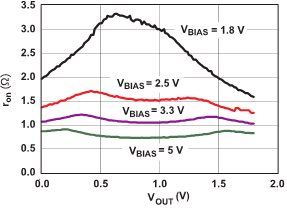 Figure 1. ron vs VOUT
Figure 1. ron vs VOUT
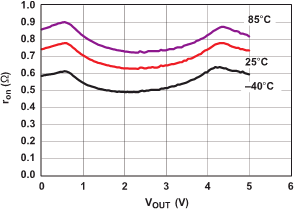 Figure 3. ron vs VOUT (VBIAS = 5 V)
Figure 3. ron vs VOUT (VBIAS = 5 V)
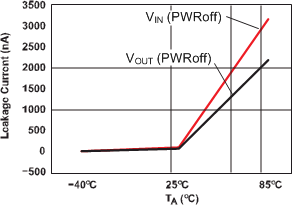 Figure 5. Leakage Current vs Temperature (VBIAS = 5 V)
Figure 5. Leakage Current vs Temperature (VBIAS = 5 V)
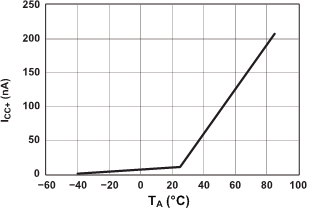 Figure 7. Power-Supply Current vs Temperature
Figure 7. Power-Supply Current vs Temperature(VBIAS = 5 V)
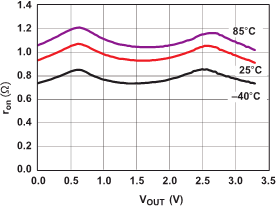 Figure 2. ron vs VOUT (VBIAS = 3.3 V)
Figure 2. ron vs VOUT (VBIAS = 3.3 V)
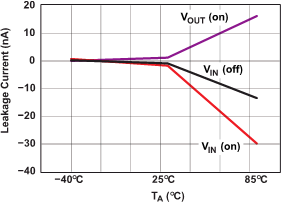 Figure 4. Leakage Current vs Temperature (VBIAS = 5.5 V)
Figure 4. Leakage Current vs Temperature (VBIAS = 5.5 V)
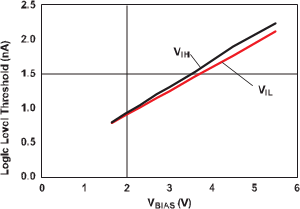 Figure 6. Logic-Level Threshold vs VBIAS
Figure 6. Logic-Level Threshold vs VBIAS